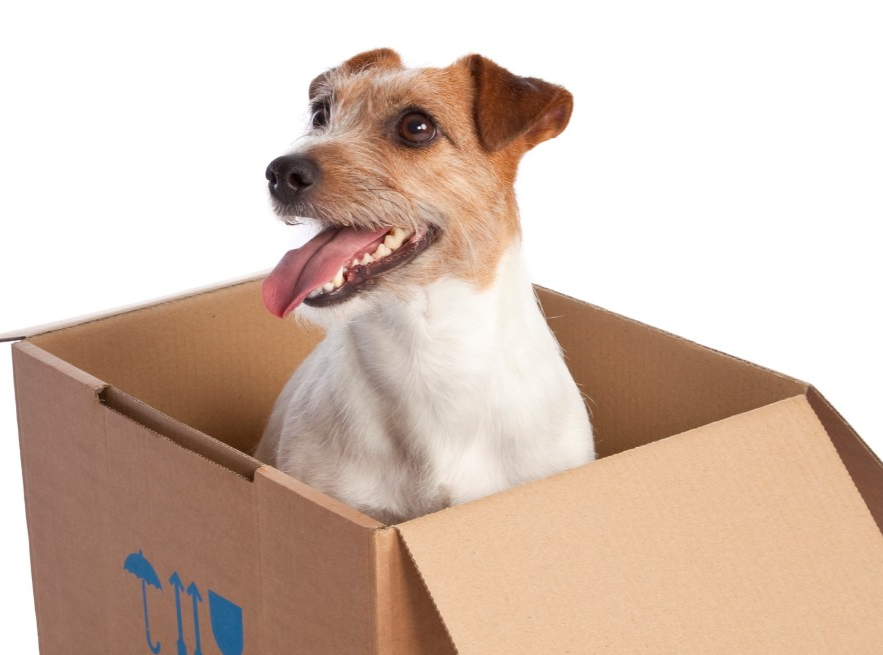If you’re like most pet owners, your pet is an important member of your family. So when it comes time to move, you want to make sure that they come with you. But moving with pets can be a challenge – after all, they’re not used to being in a new environment and may not take kindly to the upheaval.
However, with some preparation and planning, you can make the move as smooth as possible for your furry (or scaly or feathery) friend. Check out our list of 67 tips for moving with pets:
 Preparing For Moving With Pets
Preparing For Moving With Pets
If you think moving to a new home is stressful, double that stress level for your dog and even more for your cat. Here are a few tips to ease those levels before moving with a pet.
- This is just a good rule of thumb anyway, but start the moving process weeks before the moving date. Too much action at one time can be unnerving for the pet.
- Pack things in front of your animal to take away some of the unknown. Packing one or two moving boxes a night will become part of their routine, which is important to make pets feel like everything is normal.
- When it’s time to pack up your belongings and get them on the truck, empty one room first and put your dog or cat in there. This will prevent them from bolting as doors are left open for the back-and-forth trips. They also won’t be underfoot as you are moving things around. And, most important, they won’t get freaked out by all the commotion!
- If possible, get your pet acclimated to the new home with a visit or two beforehand.
- Make sure they’re up to date on their shots and other medications.
- Let the vet know about the move and transfer health information to a new vet.
- Ask about medications to make the move easier (although many pet health experts frown on sedating your pets in general).
- Find a vet before the move and make sure to transfer any history or medications your pet may need.
- Have a favorite toy, blanket, or other comfort objects on hand for the move. You want to make your pet as comfortable as possible and these can be reassuring.
- Occasional treats never hurt anyone–have plenty on hand if you sense your animal is getting anxious.
Transportation Considerations
- Even on a short road trip, it’s recommended your pets are secure. Sudden stops or starts can be quite jarring for your four-legged friend.
- Pets should always be in the back seat. If they get spooked, they may jump on your lap, obscuring your view or affecting your concentration.
- If airbags are deployed, they can really hurt your pet, too. Even in a carrier.
- Cats should never be left loose in the car–always use a carrier. For really long trips, a larger carrier is recommended.
- Although not as vital, dogs should be kept in carriers as well, especially if they are particularly skittish.
- In the days leading up to the move, get your pets acclimated to their carriers by slowly increasing their use. Reward your furry family member after each use so they begin to look forward to using the crate.
- A loose carrier is just as dangerous as a loose animal. Make sure to use seatbelts to keep the carriers in place.
- Make sure other pet environments (bird cages, terrariums for reptiles, etc.) are equally secure. Consider replacing glass enclosures with something less breakable for the drive.
- On longer trips, make frequent stops for the dog (and cat if you have a leash/harness for them) so they can stretch their legs and do their business. If you need to stay overnight somewhere, scout out pet-friendly hotels along your route.
- Keep plenty of water on hand for your animals to drink along the way.
- If multiple people are moving, make sure someone stays with the pets for an extra layer of comfort for your animals.
- Most importantly, NEVER leave your pet unattended in a car, especially on hot days.
Moving With a Pet Fish
 Moving with fish obviously has its own set of challenges because they need water to survive. But opinions are split on the best way to move your fish and the water they need to survive.
Moving with fish obviously has its own set of challenges because they need water to survive. But opinions are split on the best way to move your fish and the water they need to survive.
- No matter if you use a bucket or plastic bags, fish can survive for five hours or more during transportation.
- For longer trips, you’ll need to keep the water oxygen levels consistent. Many pet stores have devices that can keep the water oxygenated for long distances.
- Temperature is very important when moving fish. Insulated transportation devices are available, but if traveling by car, make sure it’s heated (or cooled) to desirable temps before loading the fish.
- Ammonia build-up in the water can be a huge issue over long periods. Combat this by limiting feeding 72 hours before the move to decrease metabolic processes.
- When using a bucket, make sure it is secured–otherwise, a sudden stop could make for a wet backseat and a dead fish.
- Plastic bags are ideal for moving fish because they can be sealed with a rubber band and are more pliable than a rigid bucket.
- The speed of the car won’t affect your fish, but rapid acceleration or deceleration will. Stay steady behind the wheel!
- A cooler with a secure top can be used for bigger if necessary, just make sure the fish has six inches of room on all sides.
- Situate the cooler so the fish is facing the side of the car, not the front or back. A sudden stop could cause your fish to slam its face into the cooler wall!
- If you must transport the fish in their aquarium, make sure the tank isn’t filled all the way and remove all gravel or decorations. During sudden stops, these materials can cause cracks in the tank if they are floating around loose.
Traveling By Air
 Although this isn’t recommended, there may be times when air travel is needed during a long-distance move. Different airlines have different regulations when allowing pets to fly, so make sure to do your research.
Although this isn’t recommended, there may be times when air travel is needed during a long-distance move. Different airlines have different regulations when allowing pets to fly, so make sure to do your research.
- A recent legislative law means airlines no longer need to make special accommodations for service animals, so keep that in mind.
- Arrive much earlier than usual when flying with your pet. You’ll want to check them in, find out where they need to be taken when flying in cargo, or taken through checkpoints. Doing this with only minutes to spare is exhausting!
- You can not buy a seat for your pet, so they will need to be treated like carry-on luggage.
- Smaller dogs can join you in the cabin if they fit under the seat in front of you. But considering they must be in a carrier, this is highly unlikely.
- If your pet is traveling in the cargo area of the plan, consider the outside temps. When flying in the summer, get early morning or night flights and choose midday flights during the Winter.
- Clearly label the kennel or carrier, add a phone number, and securely tape a picture of your pet in case it happens to get loose.
- Nonstop flights are best for your animal–and you for that matter! Bringing an animal onto the plane, then taking it off and rushing to your next flight adds stress to an already tense time for your pet.
- For longer flights with layovers, tape a bag of food to the carrier so airline workers can feed your pet during layovers.
- If your pet is in the cargo hold, freeze a bowl of water the night before. It won’t spill during transport to the airport and when it melts they’ll have something to drink.
- Many airlines refuse to accept animals for flights if they have been sedated. In fact, most experts recommend not sedating your animal for any reason (outside of surgery).
- Do not feed your animal in the hours leading up to the flight–a full stomach can be uncomfortable during the flight.
- Many non-traditional pets can be shipped. Research different companies to see which one best fits your needs.
Is Moving Cross Country With Pets Allowed?
To prevent new diseases from crossing the border, many states have requirements before bringing in a new animal. It’s also a good idea to make sure your less-than-traditional pet can make the trip with you or not.
 Check state laws about pet ownership
Check state laws about pet ownership
- Most traditional pets like dogs and cats are allowed in every state, but certain breeds may be forbidden. For example, Hawaii, Connecticut, and some cities don’t allow Bengal cats, and other locations only allow them if they are five generations removed from their Asian leopard ancestors.
- Some animals aren’t allowed in states at all. Dangerous animals such as jungle cats, bears, wolves, venomous snakes, and others are strictly forbidden.
- While this usually refers to exotic pets, even gerbils and hamsters will raise an eyebrow in Hawaii. Because of the delicate ecosystem, if the cute little rodents escape, they could multiply and do real damage to the surrounding environment.
- There are exceptions depending on what your pets are used for, such as educational uses. Other permissible uses include if your pet will be on exhibition. But each state is different so make sure these non-traditional pets are allowed in your new state or city boundaries.
What steps are needed to ensure you’re able to have traditional pets
- Many states require a Certified Vet Inspection before moving a dog, cat, or other pets into the state. Your veterinarian will be able to provide you with these credentials.
- Some states require Official Health Certificates to move with animals. Certain exemptions apply, such as the age of the animal, but an OHC is needed to prevent the transmission of diseases to other animals.
- Almost all states require up-to-date vaccinations for dogs and cats.
- Make sure to license your pet in your new city. This may be accomplished before the move in some cases
- There are nearly five million bird owners in the US. Did you know that some birds can be sent through the mail via USPS?
Moving With Pets And Their New Home
Now that moving day is over and you’re settling into your new home, it’s time to get the animals situated. Here are some things to think about when you prepare your pets for their new home.
- This probably goes without saying, but unpack your four-legged friends first! Let them roam around a bit and get a lay of the land. In most cases, dogs will go nuts with all the new smells while cats may be more cautious. Give them a little time to check things out.
- While the animals investigate, get their part of the home prepared. On the first day, consider putting all of their possessions in a room so they have a little bit of security–don’t forget to find a good place for the litter box. This is also a nice way to keep them away from unloading and moving stuff into the home.
- Stick to the routine you had at the old home. That structure is a great comfort to your animals and will help them return to feelings of normalcy.
- Before removing fish from their transport bag or bucket, make sure their aquarium is set up properly. Dumping a fish in water that’s too hot or too cold or doesn’t have a good pH level can shock your finned friends.
- Stay at home as much as you can during those first few days. Let’s face it, you could use the break too! Use the next 48 hours to decompress–both you and your pets!
- Don’t be stingy with affection. They may not want to be far from you at the start anyway, so plenty of pets, behind-the-ear scratches, and tummy rubs are in order!
- Don’t fret if your pet doesn’t get used to the new place right away. Although it may take a few days for them to stop showing signs of anxiety, it could take up to a month (or more) to be completely comfortable and “home.”
- Pet-proof your new house beforehand if you can. Check out the backyard fence to make sure there’s no easy escape route for the dog.
- Have a nosy pet? Add child-proofing latches on cabinet doors to keep your pets away from the garbage can or harmful chemicals that are stored under the kitchen sink.
- If you keep the kitchen garbage out in the open, make sure the lid is always firmly closed and consider ways of securing the lid that is easy for you to deal with but impossible for pets to get past.
- At the start, make sure to pick up after yourself so your dog doesn’t deal with anxiety by chewing on your stuff (shoes, gym bags, and so on). Eventually, you can be your old messy self, but for now, clean up and give your pet lots of love.
- If your water heater is in a corner, block the opening between the water heater and the corner of the room. It can be a frightening situation if your curious cat gets stuck behind there!
- Even if your cat was an outdoor cat before, you may want to keep them inside for at least a few weeks before letting them roam. Do a little neighborhood investigating to determine the safety of your adventurous feline.
One Last Thing To Think About When Moving With Pets
Ensuring your pet is happy and calm during a move will make the move that much easier. So while you’re ensuring your pet is comfortable, consider hiring Smooth Move People to take care of everything else! We can pack, load, move your stuff and unpack everything at your new home!
This way you can concentrate on reducing the stress your pets may be feeling (and your stress level lows too!) during the process and get to work making them comfortable in their new home. We’ve been in business for decades and offer the lowest rates available in Oregon. Get a move scheduled today.



